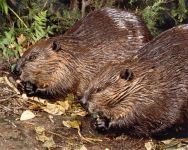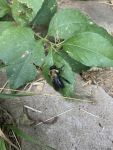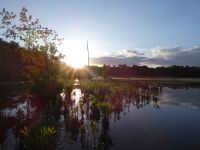Beaver Tales from Unexpected Wildlife Refuge, June 2022
Carpenter bee
Sunset over main pond
June has been an active month at Unexpected Wildlife Refuge. Mammals, birds, insects, reptiles, and amphibians are lively as the warmer temperatures of summer arrive. Every day we welcome the sights and sounds of life at the Refuge. Nesting female turtles are seen regularly in areas surrounding the ponds. Choruses of birds, frogs, and toads are heard at different times of day and night. Young toads, having completed metamorphosis, continue to emerge from the water to begin their new life on land.
News items section below.
manager@unexpectedwildliferefuge.org to schedule.
Running a wildlife refuge is not only physically and emotionally demanding, there are always expenses with which to deal. Although we are frugal in how we spend Refuge funds – having only one employee and an all-volunteer Council of Trustees – we need your help in ensuring the continuation and longevity of the Refuge. We hope you will take the time to make the most generous donation you can...now . Please know that we – and the wildlife – are grateful for your continued support.
Contents of this month's newsletter:
Support wildlife at the Refuge
AmazonSmile
UWR on AmazonSmile https://smile.amazon.com/ and choose Unexpected Wildlife Refuge as your charity. Every time you shop, be sure to choose the AmazonSmile page and UWR will receive a donation! Feel great knowing you are helping all wildlife at the Refuge!
Beaver
Helping wildlife and the Refuge in the future and wildlife . When talking with your estate planner, just provide them with our name, address and tax identification number (23-7025010 ). This is one of the most important gifts the Refuge can receive. If you have already included us in your future plans, thank you!
News items
UWR table
UWR at Folsom Green Day, April 30, 2022
Humane Stewardship Alliance
Humane Stewardship Alliance
here .
UWR table
UWR at NatureFest, June 7, 2022, by Vice President Dave Sauder
Mr. B's NatureFest in Galloway Township, sharing information about the Refuge and its mission. There were hundreds of students and many teachers from Reeds Road Elementary, and Roland Rogers and Galloway Township Middle Schools in attendance. Students were required to complete various assignments at the event. Some gave presentations regarding the local environment, flora and/or fauna, while others had to come up with a fact from at least seven presenters. I initialed worksheets for students who included facts about UWR.
Snapshots of life at the Refuge
Beaver
Beaver
Beaver on the main pond
Carolina wren nest
Carolina wren nest with eggs in propane tank
Juvenal's duskywing
Juvenal's duskywing butterfly puddles at Headquarters
Gray fox
Trustee Dave Sauder spots a fox
Southern twayblade
Repeat visitor photographs southern twayblade
Snapping turtle
Snapping turtle
Snapping turtles can take hours to lay their clutch
Ring-necked snake
Ring-necked snake
Ring-necked snake
Visit from a ring-necked snake
Visitor spotlight
Main pond
Longtime supporter, Gary Wonderlin shares about recent Refuge visit
Beavers in the news
Here are some recent news media articles concerning beavers. You can see our entire and growing list, a tribute to this wonderful keystone species, in our Beavers in the News page . If you come across a news item on beavers, please send us the link so that we can consider it for inclusion.
Beaver Relocation Underway in Gifford Pinchot National Forest , by Shari Phiel.
Beaver habitat
Jakubowski and White have now been working together on the Woods Creek project for more than a year. In April 2021, White released two adult beaver in the area, and there are signs that at least one has remained. Although no beaver were spotted Thursday, there were signs of recent activity, such as chewed tree stumps and use of the artificial beaver dams.
Cumberland Abandons Plan to Trap ‘Nuisance’ Beavers Because State Law Requires They Be Killed, Not Relocated , by Colleen Cronin.
Beaver
A town plan to trap “nuisance” beavers to reduce the flooding they cause has been halted after a town official learned the captured animals would be killed.
Help wildlife everywhere
Gray wolf
Reinstate Endangered Species Protections For Gray Wolves here .
Bees
Help Save Our Bees and the Planet! here .
Contact us
Unexpected Wildlife Refuge
http://unexpectedwildliferefuge.org/
info@unexpectedwildliferefuge.org








